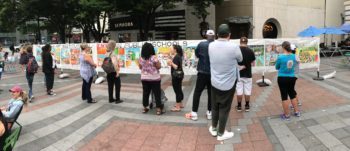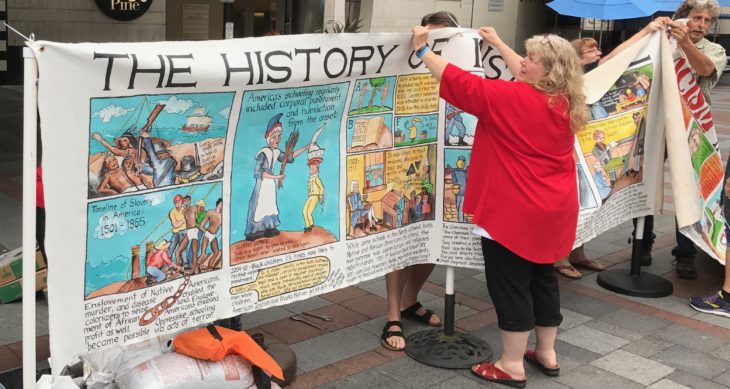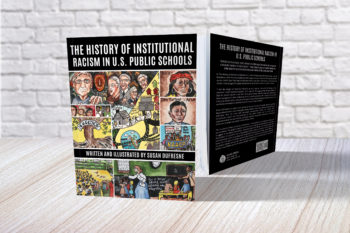By Anthony Cody.
Last July, I joined several hundred people for a Restorative Justice Circle in downtown Seattle, sponsored by the Badass Teachers Association. The event was a somber one, featuring heartfelt discussions of the impact of racism, and the commitments each of us were willing to make to take on racism in our lives and work.
The backdrop for the event was an amazing set of banners, painted by Susan DuFresne, that told the story of institutional racism in public schools. Each banner was about four feet tall, and fifteen feet long. Following the rally, we marched to the headquarters of the Gates Foundation, where we protested their continuing role in promoting privatization and standardized testing practices that are damaging the lives of students of color.
The banners next made an appearance at the Network for Public Education conference, where they hung from the walls, as these issues were discussed by activists from all over the country
The banners spark conversation. When they are visible, they draw people to study and read them. In the Seattle park, passersby young and old took time to walk slowly by, reading the panels, and talking about the ways they have seen racism in their own lives. At the end of the event, participants wrote personal pledges regarding the fight against racism on the back of the banner.
When Denny Taylor at Garn Press saw photos from these events, she understood the potential impact this work could have. With the talents of her son, Ben Taylor, they have designed a beautiful book that makes these panels accessible to everyone, and the timing could not be better.
The raw truthtelling DuFresne delivers is demanded by the lies we are being told. When our president asserts that “Our ancestors tamed a continent,” it is imperative that the real history be laid bare. Beginning from the age of Columbus, DuFresne shows how the children of the indigenous and enslaved were special targets for the settlers arriving on a continent inhabited by well developed cultures, and various forms of “education” were used to eliminate those cultures and languages.
Through her hand-painted illustrations, DuFresne brings scenes to life, so we see the faces of the Native American children taken from their families to be “re-educated” at boarding schools. We learn of the rationales that supported these practices. We also learn of resistance – the schools organized to serve African American children after the Civil War. We learn of the Freedom Schools of the Civil Rights Movement.
But the book does not treat racism as a thing of the past. DuFresne draws a direct line between the racism of the Eugenics movement, which brought standardized testing into the mainstream a hundred years ago, and the use of such tests today to justify school closures. Her pictures convey the impact of phony reforms like No Child Left Behind, Race to the Top and the Common Core, and the billionaires promoting them. Some of the proceeds of the book will be donated to anti-racist movements.
Recent research has shown that when students are taught that our social systems are “fair” to all, this has a perverse effect. Students of color reach middle school age and discover that this fairness is a myth, and in fact, racism continues to limit their opportunities. This discovery can lead to bitter disillusion, and even rebellious behavior. Those of us who have taught middle school students are familiar with this. This book offers us a chance to acknowledge and understand the reality that our students are grappling with. It should be required reading by educators and students alike, as it helps us understand the world we live in, so we can work together to change it.
The book can be ordered at your local bookstore, or at Barnes and Noble here, or Amazon here.






jim2812
Roxanne Dunbar-Ortiz, LOADED: A Disarming History of the Second Amendment, uncovers the fake history of the sanctimony associated with the Second Amendment right to bare arms and she shows colonial racist history of the right to bare arms and that has allowed U.S. gun culture to support domestic and global massacres.